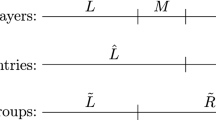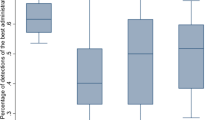Abstract
In this paper, we construct a theoretical game model with incomplete information to analyze the tax revenues of a multiethnic country, when fiscal corruption is widespread. Our proposal is that income inequality between ethnic groups causes differences leading to prejudice and discrimination among ethnic groups themselves and, as a consequence, this affects the control of corruption and evasion. Hence, the amount of tax revenues is proven to be dependent on the relevance of the income distribution between the ethnic groups.
Similar content being viewed by others
Notes
Fiscal corruption applies when a fiscal officer (tax inspector) decides to engage in corrupt behavior, i.e. asks for a bribe to an evading taxpayer in order to report that evasion does not occur.
It is important to stress that corruption and tax evasion are two different phenomena although coexist very often. Countries characterized by a widespread corruption are argued to be plagued by relevant tax evasion activities as well (Tanzi and Davoodi 2001). In fact, data show that countries with higher levels of corruption collect fewer taxes per unit of GDP than those with less corruption [see e.g. Johnson et al. (1999) and Tanzi and Davoodi (1998, 2001)]. Both corruption and tax evasion hinder the entrepreneurial initiative and discourage investments, distorting the mechanism of the economic competition and putting firms in unequal conditions. In addition both corruption and tax evasion reduce public budget, which implies a difficulty to carry on social, educational and public health protection program. Clearly, tax evasion is a unilateral act put in place by the entrepreneur, while corruption is a transaction that takes place between two parties.
Allport (1954) defines ethnic prejudice as an antipathy based upon a faulty and inflexible generalization.
Early work established that patterns of intergroup behavior can be understood by considering that individuals may attribute positive utility to the well–being of members of their own group and negative utility to that of members of other groups (see e.g. Tajfel et al. 1971).
It is assumed that no arbitrage is possible between the public and the private sector and that therefore there is no possibility for the public officials to become entrepreneurs, even if their salary is lower than the entrepreneurs’ net return. This happens because the public officials in the population have different skills from the entrepreneurs, and therefore may not become entrepreneurs.
It is out of the scope of the paper to deal with discussion about the ethnic distribution of the population. Nevertheless, as already pointed out above, this paper deals with a theoretical discussion of empirical results stemming from the analysis of developed countries. Hence, we assume that the situation of a small number of ethnic groups containing the entire population of controllers and tax inspectors—which is rather standard in developing countries—does not occur.
We assume that a taxpayer is seen by only one inspector and cannot turn to other inspectors to be treated differently.
It is worth noticing that the controllers do not have information about the tax inspectors and the taxpayer’s ethnic group before the check. In this, we do not deal with political corruption but bureaucratic corruption (petty corruption). In this case, the controller does not know which transaction to check until a superior tells her/him the assigned tasks and s/he cannot refuse to check the transactions which have been allocated. The case in which the fiscal transaction can be selected by the controller should be associated to a discussion on the decision criterion of the bureaucrat, and this is beyond the scopes of the present paper.
Conversely, Allingham and Sandmo (1972) first consider the penalty as a proportion of the unreported production. Caballé and Panadés (2007) show that when penalties are imposed proportionally to the amount of evaded taxes, the rate of capital accumulation cannot increase with the tax rate, while if the penalties are imposed on the amount of unreported production, the amount of production concealed increases with the tax rate.
In fact, as Alm and Togler (2006) stated, if taxpayers’ values are influenced by cultural factors, then tax morale may be an important determinant of taxpayer compliance and other forms of behavior.
The justification of the difference between ethnic groups in terms of the reputation costs is based on Fisman and Miguel (2007). The authors discuss the parking behavior of the United Nations diplomats in Manhattan, which may then represent a proxy of the honesty level of the Countries and, in a broader sense, of the different ethnic groups. We refer to the quoted paper for the details.
This assumption can be more easily understood when there is extortion by the tax inspector, rather than corruption, even though the relevant provisions or laws in many countries stipulate that the bribe shall, in any case, be returned to the taxpayer and that combined minor punishment (penal and/or pecuniary) be inflicted on her/him.
If mq e,c,i = 1, the bribe is never negotiated and the corresponding stage of the game is never reached.
References
Alesina, A., & Glaeser, E. (2004). Fighting poverty in the US and Europe. A world of difference. Oxford: Oxford University Press.
Alesina, A., Glaeser, E., & Sacerdote, B. (2001). Why doesnt the US have a European-style welfare state? Harvard Institute of Economic Research, Discussion Paper Number 1933.
Alesina, A., Devlseschawuer, A., Easterly, W., Kurlat, S., & Wacziarg, R. (2003). Fractionalization. Journal of Economic Growth, 8(2), 155–194.
Alesina, A., Michalopoulos, S., & Papaioannou, E. (2012). Ethnic inequality. NBER Working Paper No. 18512.
Allingham, G.M., & Sandmo, A. (1972). Income tax evasion: a theoretical analysis. Journal of Public Economics, 1, 323–338.
Alm, J., & Torgler, B. (2006). Culture differences and tax morale in the United States and in Europe. Journal of Economic Psychology, 27, 224–246.
Allport, G. W. (1954). The nature of prejudice. Boston: Beacon Press.
Alt, J.E., & Lassen, D.D. (2008). Inequality and corruption: Evidence from US States. EPRU Working Paper Series.
Andres, A., & Ramlogan-Dobson, C. (2011). Is corruption really bad for inequality? Evidence from Latin America. The Journal of Development Studies, 47(7), 959-976.
Becker, G. S. (1957). The economics of discrimination. Chicago & London: The University of Chicago Press.
Becker, G. S. (1968). Crime and punishment: An economic approach. Journal of Political Economy, 76, 169-217.
Caballé, J., & Panadés, J. (2007). Tax rates, tax evasion, and growth in a multi-period economy. Revista de Economia Publica 183(4), 67-80.
Celentani, M., & Ganuza, J.-J. (2002). Organized versus competitive corruption. Annals of Operations Research, 109, 293–315.
Cerqueti, R., & Coppier, R. (2009). Tax revenues, fiscal corruption and “shame” costs. Economic Modelling, 26(6), 1239–1244.
Cerqueti, R., & Coppier, R. (2011). Economic growth, corruption and tax evasion. Economic Modelling, 28(1–2), 489–500.
Cerqueti, R., Coppier, R., & Piga, G. (2012). Corruption, growth and ethnolinguistic fractionalization: A theoretical game model. Journal of Economics, 106, 153–181.
Chander, P., & Wilde, L. (1992). Corruption in tax administration. Journal of Public Economics, 49, 333–349.
Chong, A., & Calderòn, C. (2000). Institutional quality and income distribution. Economic Development and Cultural Change, 761–786.
Collier, P. (2001). Implications of ethnic diversity. Economic Policy, 32(16), 127-166.
Dobson, S., & Ramlogan-Dobson, C. (2010). Is there a trade-off between income inequality and corruption? evidence from Latin America. Economics Letters, 107(2), 102-04.
Echevarria, C., & Calver, M. (2010). Ethnic income inequality in Canada. New York: Mimeo.
Feichtinger, G., Grienauer, W., & Tragler, G. (2002). Optimal dynamic law enforcement. European Journal of Operational Research, 141, 58–69.
Fisman, R., & Miguel, E. (2007). Corruption, norms, and legal enforcement: Evidence from diplomatic parking tickets. Journal of Political Economy,115(6), 1020–1048.
Fjeldstad, O.-H., & Tungodden, B. (2003). Fiscal corruption: A vice or a virtue?. World Development, 31(8), 1459–1467.
Johnson S., Kaufman, D., & Zoido-Lobaton, P. (1999). Corruption, public finances, and the unofficial economy. The World Bank, WPS 2169.
Hindriks, J., Keen, M., & Muthoo, A. (1999). Corruption, extortion and evasion. Journal of Public Economics, 74, 394–430.
Kim, Y. (2003). Income distribution and equilibrium multiplicity in a stigma-based model of tax evasion. Journal of Public Economics, 87, 1591–1616.
Macrae, J. (1982). Underdevelopment and the economics of corruption: A game theory approach. World Development, 10(8), 677-687.
Mesterton-Gibbons, M. (2000). An introduction to game-theoretic modelling, American Mathematical Society, Rhode Island.
Moulin, H. (1986). Game theory for the social sciences, second and revised edition, Second and Revised Edition. New York: New York University Press.
Navas, J., & Marin-Solano, J. (2008). Interactions between government and firms: A differential game approach. Annals of Operations Research, 158, 47–61.
Pasetta, V. (1999). Dynamics in divide the money game with bribing. Annals of Operations Research, 88, 361-377.
Rose-Ackerman, S. (1975). The economics of corruption. Journal of Public Economics, 4, 187–203.
Rose-Ackerman, S. (1978). Corruption, a study in political economy. Chicago: Academic Press.
Sanyal, A., Gang, I. N., & Gosswami, O. (2000). Corruption, tax evasion and the Laffer Curve. Public Choice, 105, 61–78.
Saulo, H., Rego, L. C., & Divino, J. A. (2013). Fiscal and monetary policy interactions: a game theory approach. Annals of Operations Research, 206(1), 341–366.
Shleifer, A., & Vishny, R. (1995). Corruption. The Quarterly Journal of Economics, 108(3), 599–617.
Tajfel, H., Billig, M., Bundy, R.P., & Flament, C. (1971). Social categorization and intergroup behavior. European Journal of Social Psychology, 1, 149–178.
Tajfel, H., & Turner, J.C. (1986). The social identity theory of inter-group behavior. In S. Worchel, L. W. Austin (Eds.), Psychology of intergroup relations. Chigago: Nelson-Hall.
Tanzi, V., & Davoodi, H. R. (1998). Corruption, public investment and growth. In H. Shibata, T. Ihori (Eds.), The welfare state, public investment and growth (pp. 41–60). Berlin Heidelberg New York: Springer.
Tanzi, V., & Davoodi, H. R. (2001). Corruption, growth, and public finances. In K.J. Arvind (Eds.), Political economy of corruption (pp. 89–110). London: Routledge.
Yitzhaki, S. (1974). Income tax evasion: A theoretical analysis. Journal of Public Economics, 3(2), 201–202.
Author information
Authors and Affiliations
Corresponding author
Rights and permissions
About this article
Cite this article
Cerqueti, R., Coppier, R. A game theoretical analysis of the impact of income inequality and ethnic diversity on fiscal corruption. Ann Oper Res 243, 71–87 (2016). https://doi.org/10.1007/s10479-014-1567-9
Published:
Issue Date:
DOI: https://doi.org/10.1007/s10479-014-1567-9




